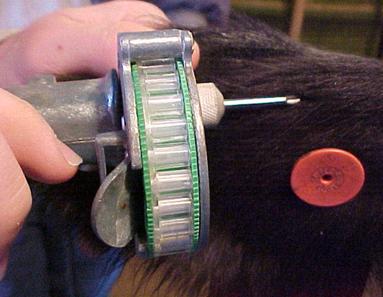
Agricultural News
OSU Professor Examines the Facts Regarding the Safety of Hormone-Implanted Beef
Fri, 07 Sep 2012 12:10:32 CDT

Dr. Josh Payne, area animal waste management specialist with Oklahoma State University, has written the following article in hopes of shedding some light on the misunderstood subject of hormones and beef.
Questions exist in the public sector regarding the safety of consuming hormone-implanted beef. In short, the use of supplemental hormones in beef production has been scientifically proven as safe for consumers and is approved by the US Food and Drug Administration (FDA). For those still in question, let's further examine the science supporting these facts.
Hormones are products of living cells naturally found in both plants and animals that often stimulate cellular activity. There are six hormones approved for use in beef production. Three are natural hormones (testosterone, estradiol, and progesterone) and three are chemically similar synthetic hormones (melengestrol acetate, trenbolone acetate and zeranol).
Growth hormones in beef are primarily administered using a small pelleted implant that is placed under the skin on the back of the ear. The implants are designed to release the hormone slowly over time into the bloodstream. This ensures that hormone concentrations remain constant and low. Since the ear is discarded at harvest, the implant does not enter the food chain. Implants work by increasing the amount of growth regulating hormones, which are naturally produced by the animal. This, in turn, increases feed efficiency, protein deposition and growth rate. Implanted calves usually result in a 10-20% increase in average daily gain (growth rate) compared to non-implanted calves. Moreover, because of the increased feed efficiency, less feed is required which decreases production costs by 5-10%.
Since implant doses are low, the use of implants in cattle has very little impact on hormone levels in beef. For example 500 grams ( about 1 lb.) of beef from an implanted steer contains approximately 7 nanograms of estrogen compared to 5 nanograms of estrogen from non-implanted beef. Furthermore, there are many common foods that are naturally much higher in estrogen than implanted beef. For example, 500 grams of tofu contains 16,214,285 times the amount of estrogen compared to the same amount of implanted beef. To gain additional perspective on the minuteness of these measurements, nanograms are equivalent to1 billionth of a gram. One gram is roughly equal in weight to 1 small paper clip. If we were to divide the same paper clip into 1 billion tiny pieces, one of those tiny pieces would equal 1 nanogram.
Some consumers question whether consuming beef implanted with hormones can cause cancer or early puberty in children. Hormone implanted beef has never been implicated in adverse health effects in humans. However, height, weight, diet, exercise and family history have been found to influence the age of puberty. Furthermore, the amount of estrogen consumed in implanted beef is negligible compared to the amount the human body produces each day. The average non-pregnant woman produces 513,000 nanograms per day. The average man's body produces 136,000 nanograms per day. An average child will produce 41,000 nanograms of estrogen per day.
Regarding potential environmental concerns associated with growth hormones, the FDA has determined that the use of natural hormones in beef does not pose a risk to the environment as the amounts administered to calves are much lower than amounts naturally produced by adult cattle. Regarding synthetic hormones, extensive environmental risk studies have been conducted and the FDA has determined that the use of these hormones will not significantly impact the environment.
Most of the beef cattle produced in the US spend most of their lives in a pasture and are then finished in a feedlot where they are given a grain-fed diet. Beef that are finished in a feedlot with the aid of growth hormones require less total land mass, less feed crops and create fewer greenhouse gasses per pound of beef produced compared to non growth hormone pasture-based finishing systems.
Consumers that prefer to purchase naturally produced or organic beef raised without growth hormones should be prepared to pay a premium. Implanting beef reduces the cost and resources required in beef production and that results in lower costs that are passed on to the consumer.
References: Loy, D., 2011. Understanding hormone use in beef cattle Q&A. Iowa State University Extension. Click here to read the full study.
WebReadyTM Powered by WireReady® NSI
Top Agricultural News
More Headlines...




















